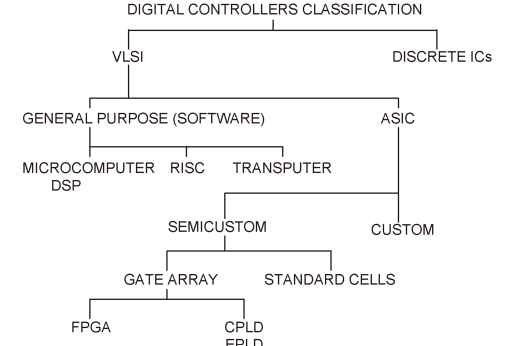
The figure shows the classifications for different types of digital controllers. Broadly, digital control of power electronic systems is possible by means of VLSI (very large scale integration) or discrete IC (integrated circuit) based hardwired controllers. The latter may combine digital and analog ICs. In a VLSI, a very large number of devices are integrated monolithically in a chip to provide great simplification of hardware. A VLSI chip may use digital, analog, or mixed signals. Current submicron (0.10 |jm or smaller) CMOS and BiCMOS technologies permit very large scale integration (several million equivalent gates). Again, a VLSI chip can be either general purpose for software programs, or application specific IC (ASIC), that is, designed for a particular application. Examples of ASIC chips are the AD2S100/AD2S110 vector controller (Analog Devices) and NLX230 fuzzy controller (American Neurologix). General-purpose VLSI chips can be subdivided into microcomputer/DSPs, RISCs (reduced instruction set computers), and transputers. In the microcomputer category, the instruction set is complex, which results in a complex architecture and sluggish computation. With RISCs, the simple architecture allows for high speeds. A transputer is specially designed for high-speed parallel processing using several processors. The ASIC chip can be classified as custom or semicustom, where the latter is again subclassified into gate array and standard cells.
A custom ASIC chip (not programmable) is very economical and is designed for specific applications in large volume, such as laundry washer control. An ASIC chip can be designed with digital, analog, memory elements (ROM, RAM), and RISC or DSP core to satisfy full control function. The gate array consists of a matrix of simple logic gates that are interconnected by the user in a field programmable GA (FPGA) or programmable logic device (PLD), which can be programmed electrically (EPLD) or by mask (CPLD) similar to EPROM or PROM, respectively. Standard cells are interconnected functional circuits (such as D flip-flop, counters, etc.) to provide more efficient performance and effective chip real estate utilization than gate arrays. Any of these chips can use a combination of analog, digital, and memory devices to design a complete system, as mentioned before.